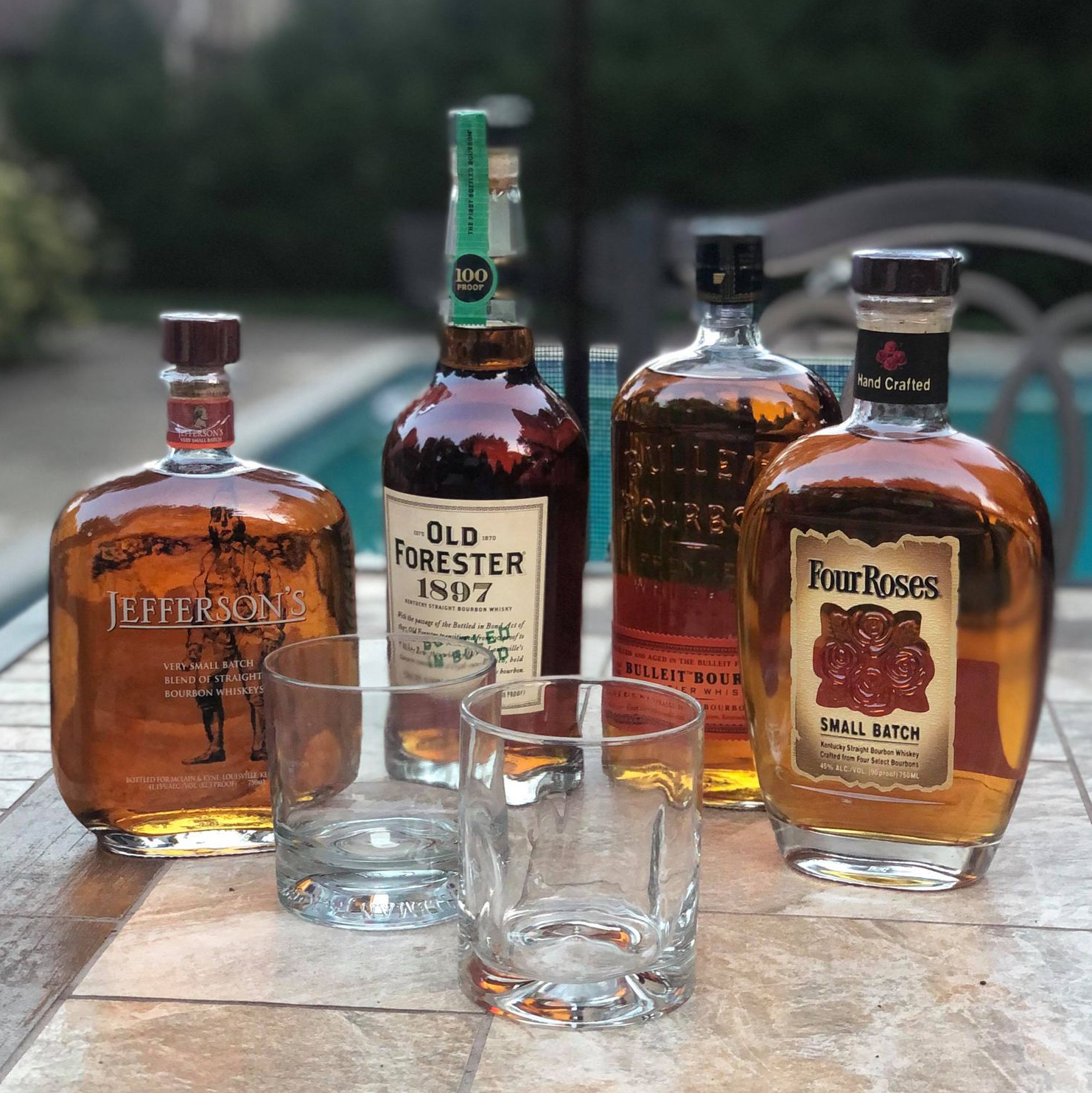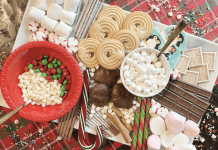While bottles of rosé go hand in hand with sun-drenched days and poolside boomerangs, I find that crisp fall days can only be matched by a slow sip of bourbon. The amber liquid looks like a late summer sunset, smells of oak, and feels like a warm hug.
Much like wine, there is a complexity to bourbon that can be appreciated by tasting and there is no better time than early autumn to grab a few bottles and host a tasting session.
First things first, what is bourbon?
 There isn’t really a simple explanation to this, so hang on while I dump some boozy knowledge on you:
There isn’t really a simple explanation to this, so hang on while I dump some boozy knowledge on you:
- Bourbon is a whiskey. By definition, whiskey (or whisky) is any distilled liquor made from a fermented mash of cereal grain such as barley, malt, rye, wheat or corn that is aged in wooden containers.
- If it is made in the United States or Ireland? It is whiskey. Scotland, Canada and Japan make whisky (no e).
- Scotch is mainly malted barley heated over fire to infuse a smoky taste. It needs to be produced in Scotland to claim the title.
- Rye whiskey uses rye or a mixture or rye and malt. In the U.S. there are minimum requirements to classify as a rye whiskey, Canadian rye whisky does not specify.
- Bourbon was first produced in Kentucky and uses over half of the mash from corn. It also uses a sour mash process fermented with yeast. In order to be called bourbon it needs to be made in the United States.
In summary, all bourbon is whiskey, but not all whiskey is bourbon.
So what do you need to host a tasting?
The shopping list is less complex than the history of the drink.
Glasses, water, bourbon, snacks. That’s all.
Glasses: You can use any glasses you have around. Traditionally a glass with a small opening such as a Glencairn or snifter will help to concentrate the aroma but you can get by with white wine glasses, rocks glasses, or even disposable plastic. You can use a different glass for each sampling or just plan on your guest rinsing out with water in between (added bonus: palate cleanser!).
Water: When tasting, it’s recommended to have a second sip with a few drops of water to “open up” the aroma. This will also dull down the proof and can make the experience a little less intense with the stronger flavors. While experienced tasters will recommend distilled water with an eyedropper, a water glass and teaspoon at every place setting is perfect. Make sure to have full pitchers around for refills!
Bourbon: In order to sample different flavors and understand the nuances from bottle to bottle, a proper tasting should include three bourbons. You can add more if you like, it just depends how much you want to actually remember about your tasting. Below, you’ll find some of our recommendations at three different price points. If these options aren’t available, your local liquor store should be able to recommend a substitution.
Snacks: A tasting isn’t complete without some eats! Food will coat the stomach, slowing the absorption of alcohol. Quick and easy bites, bowls of salted nuts, crackers for palate cleansing and some density will make sure the booze doesn’t hit you too fast. Stay away from fried foods, rich flavors or too much cheese (this isn’t wine tasting, after all). We’ve included a few ideas for pairing below.
For extra credit, you can provide tasting mats (easily found as free printables online), or you can roll out some butcher paper across the table and put down some markers. This will let your guests take notes on each sampling.
Now what am I supposed to be “tasting?”
There’s a difference between drinking and tasting bourbon. Drinking is when you mix it with ice and Coke and toss it back. Tasting is appreciating the multilayered experience of the bourbon.
- Each pour should be about a half ounce of bourbon. The first thing you’ll notice is the appearance. This can be enhanced against light source or white paper. Swirl the glass gently. Is the bourbon clear or cloudy? Light yellow or deep brown? Usually the darker the color, the longer it has been aged.
- The next consideration is the aroma. Your sense of smell is much stronger than your sense of taste. Keep your lips open and inhale above the opening of the glass. What smells are you picking up on? Some dominant notes will be caramel and vanilla, but see if you can identify more. Fruity, spicy, floral, herbal, or woodsy can all be used to describe bourbon.
- When you finally take a sip you want to really taste the bourbon. Move it around your mouth and “chew” a little bit letting it coat your tongue. Different areas of the tongue will appreciate different flavors—the tip will notice the sweet, salty toward the middle, and bitter further toward the back.
- Lastly is the finish. This is the experience after swallowing. A longer finish will linger on while a short finish will go away fast. What textures and flavors remain in your mouth? Do you feel a warmth throughout your body or more of a burn?
After the first sip, you can introduce a few drops of water and repeat the process. A higher proof may require a little more but still, be conservative. It’s really impressive how different the flavor profile can be with a little bit of water.
To cleanse the palate between samplings, you can sniff some coffee beans. A swish of water or some crackers can help, too.
Recommendations for the Bar
As with most liquors, bourbon has several price points to choose from. Once you’ve done some tasting and understand the flavors, you will appreciate the finer options. But that doesn’t mean the lower-priced bottles are not worthy. Some of our go-to, sitting around the campfire sippers are in the lower bracket. Here are a few of our favorites:
Under $30
- Rittenhouse Rye
- Buffalo Trace
- Old Forester 100 Proof
- Elijah Craig Small Batch
- Bulleit
$30-40
- Evan Williams Single Barrel
- Templeton Rye
- Makers 46
- 4 Roses Small Batch
- Eagle Rare
$40-$60
- Old Forester 1897
- 4 Roses Single Barrel
- Breckinridge Bourbon
- Jefferson’s Reserve Very Old Very Small Batch Bourbon Whiskey
- Woodford Reserve Double Oaked
Snacks to Pair with Bourbon
For the true connoisseur, there are many specific flavors in bourbon that can be singled out and paired with similar flavors in foods. Spicy bourbons pair well with spicy or peppery foods and strong cheese, while sweeter bourbons pair well with sweet or milder foods. Many sweet foods pair very well with all types of bourbon. Charcuterie is always a good option, too. As you learn the unique characteristics of each bourbon, you can sample with more in-depth food pairings. Some basic ideas to get you started with complimentary flavors are:
Sweets
- Soft caramels
- Chocolate
- Butterscotch oatmeal cookies
- Molasses cookies
- Pumpkin pie
- Apple fritters
Cheeses
- Strong bleu
- Baked Brie
- Aged cheddar
- Smoked cheeses
Nuts and Fruits
- Cashews
- Roasted or Marcona almonds
- Pecans, plain or candied
- Apples or pears
- Figs
- Oranges
Meats
- Grilled steak
- Peppered bacon
- Smoked salmon
- Meatballs
Now that you have all the information needed to host a tasting, it’s time to head to the liquor store! Go on, have a little fun! It’s been a heavy year. Stay safe and enjoy.










